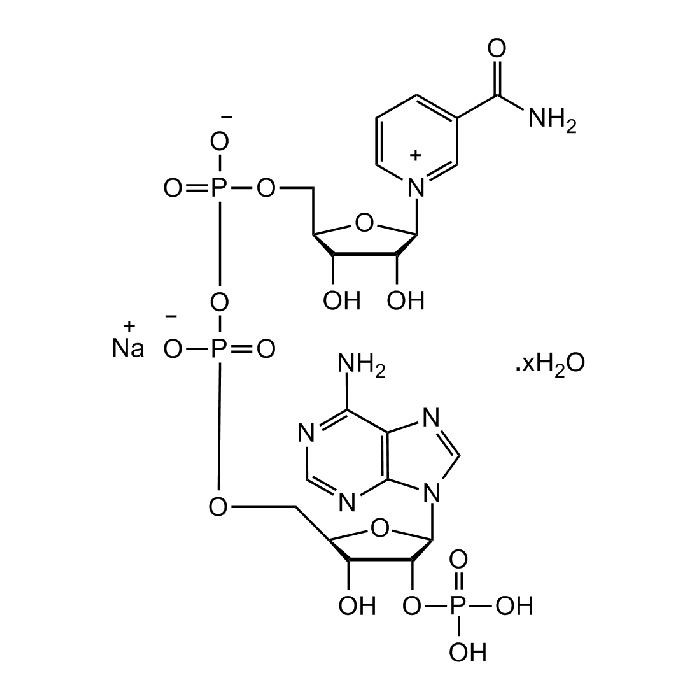Cookie Policy: This site uses cookies to improve your experience. You can find out more about our use of cookies in our Privacy Policy. By continuing to browse this site you agree to our use of cookies.
Chemodex
β-Nicotinamide adenine dinucleotide phosphate

| Product Details | |
|---|---|
| Synonyms | Coenzyme II; β-NADP; NADP+; TPN; Triphosphopyridine nucleotide sodium salt hydrate |
| Product Type | Chemical |
| Properties | |
| Formula |
C21H27N7NaO17P3 . xH2O |
| MW | 765.39 (anhydrous basis) |
| CAS | 698999-85-8 |
| Source/Host Chemicals | Synthetic |
| Purity Chemicals | ≥98% (HPLC) |
| Appearance | White to off-white powder. |
| Solubility | Soluble in water (30mg/ml). |
| Identity | Determined by 1H-NMR. |
| Declaration | Manufactured by Chemodex. |
| Other Product Data |
Click here for Original Manufacturer Product Datasheet |
| InChi Key | JNUMDLCHLVUHFS-QYZPTAICSA-M |
| Smiles | O[C@H]1[C@@H](OP(O)(O)=O)[C@H](N2C=NC3=C2N=CN=C3N)O[C@@H]1COP([O-])(OP(OC[C@@H]4[C@@H](O)[C@@H](O)[C@H]([N+]5=CC(C(N)=O)=CC=C5)O4)([O-])=O)=O.[Na+] |
| Shipping and Handling | |
| Shipping | AMBIENT |
| Short Term Storage | +4°C |
| Long Term Storage | -20°C |
| Handling Advice | Protect from light and moisture. |
| Use/Stability | Stable for at least 2 years after receipt when stored at -20°C. |
| Documents | |
| Product Specification Sheet | |
| Datasheet |
 Download PDF Download PDF |
NADP+ is the oxidized form of the electron donor nicotinamide adenine dinucleotide phosphate. It is a cofactor used in anabolic reactions, such as the Calvin cycle, lipid syntheses and nucleic acid syntheses, which require NADPH as a reducing agent. It serves as a cofactor in various biological reactions. In addition, the balance between these reduced and oxidized forms plays key roles in diverse cellular functions, including cell survival, the maintenance of redox status and intracellular signaling. For example, binding of NADP+ to β-subunits of Kv channels activates ion transport, whereas NADPH stabilizes channel inactivation. NADP+ is biosynthesized from NAD+ by NAD kinase, with ATP as the phosphoryl donor. NADP+ might be useful for immunometabolism research.
(1) F. Shi, et al.; Acta Biochim. Biophys. Sin. 41, 352 (2009) | (2) J.B. Jackson; BBA 1817, 1839 (2012) | (3) M. Nakamura, et al.; Circ. Res. 111, 604 (2012) | (4) P.J. Kilfoil, et al.; Circ. Res. 112, 721 (2013) | (5) M. Ziegler; FEBS J. 272, 4561 (2014) | (6) R. Ramalho, et al.; Sem. Immunopathol. 42, 279 (2020)





